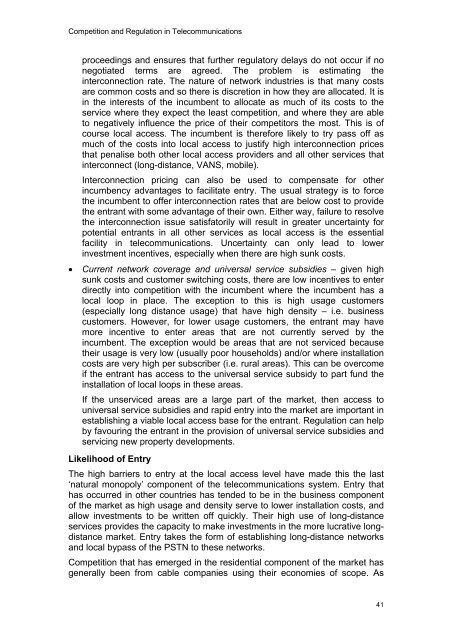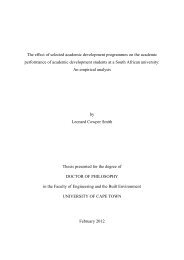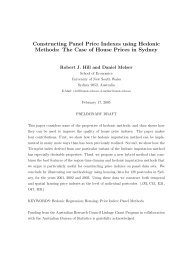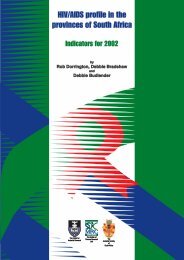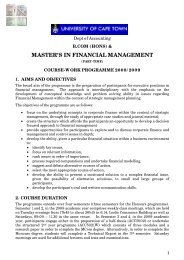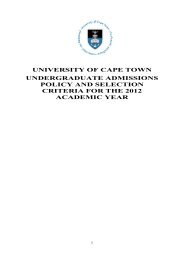Competition and Regulation in the Telecommunications Industry in ...
Competition and Regulation in the Telecommunications Industry in ...
Competition and Regulation in the Telecommunications Industry in ...
Create successful ePaper yourself
Turn your PDF publications into a flip-book with our unique Google optimized e-Paper software.
<strong>Competition</strong> <strong>and</strong> <strong>Regulation</strong> <strong>in</strong> <strong>Telecommunications</strong>proceed<strong>in</strong>gs <strong>and</strong> ensures that fur<strong>the</strong>r regulatory delays do not occur if nonegotiated terms are agreed. The problem is estimat<strong>in</strong>g <strong>the</strong><strong>in</strong>terconnection rate. The nature of network <strong>in</strong>dustries is that many costsare common costs <strong>and</strong> so <strong>the</strong>re is discretion <strong>in</strong> how <strong>the</strong>y are allocated. It is<strong>in</strong> <strong>the</strong> <strong>in</strong>terests of <strong>the</strong> <strong>in</strong>cumbent to allocate as much of its costs to <strong>the</strong>service where <strong>the</strong>y expect <strong>the</strong> least competition, <strong>and</strong> where <strong>the</strong>y are ableto negatively <strong>in</strong>fluence <strong>the</strong> price of <strong>the</strong>ir competitors <strong>the</strong> most. This is ofcourse local access. The <strong>in</strong>cumbent is <strong>the</strong>refore likely to try pass off asmuch of <strong>the</strong> costs <strong>in</strong>to local access to justify high <strong>in</strong>terconnection pricesthat penalise both o<strong>the</strong>r local access providers <strong>and</strong> all o<strong>the</strong>r services that<strong>in</strong>terconnect (long-distance, VANS, mobile).Interconnection pric<strong>in</strong>g can also be used to compensate for o<strong>the</strong>r<strong>in</strong>cumbency advantages to facilitate entry. The usual strategy is to force<strong>the</strong> <strong>in</strong>cumbent to offer <strong>in</strong>terconnection rates that are below cost to provide<strong>the</strong> entrant with some advantage of <strong>the</strong>ir own. Ei<strong>the</strong>r way, failure to resolve<strong>the</strong> <strong>in</strong>terconnection issue satisfatorily will result <strong>in</strong> greater uncerta<strong>in</strong>ty forpotential entrants <strong>in</strong> all o<strong>the</strong>r services as local access is <strong>the</strong> essentialfacility <strong>in</strong> telecommunications. Uncerta<strong>in</strong>ty can only lead to lower<strong>in</strong>vestment <strong>in</strong>centives, especially when <strong>the</strong>re are high sunk costs.• Current network coverage <strong>and</strong> universal service subsidies – given highsunk costs <strong>and</strong> customer switch<strong>in</strong>g costs, <strong>the</strong>re are low <strong>in</strong>centives to enterdirectly <strong>in</strong>to competition with <strong>the</strong> <strong>in</strong>cumbent where <strong>the</strong> <strong>in</strong>cumbent has alocal loop <strong>in</strong> place. The exception to this is high usage customers(especially long distance usage) that have high density – i.e. bus<strong>in</strong>esscustomers. However, for lower usage customers, <strong>the</strong> entrant may havemore <strong>in</strong>centive to enter areas that are not currently served by <strong>the</strong><strong>in</strong>cumbent. The exception would be areas that are not serviced because<strong>the</strong>ir usage is very low (usually poor households) <strong>and</strong>/or where <strong>in</strong>stallationcosts are very high per subscriber (i.e. rural areas). This can be overcomeif <strong>the</strong> entrant has access to <strong>the</strong> universal service subsidy to part fund <strong>the</strong><strong>in</strong>stallation of local loops <strong>in</strong> <strong>the</strong>se areas.If <strong>the</strong> unserviced areas are a large part of <strong>the</strong> market, <strong>the</strong>n access touniversal service subsidies <strong>and</strong> rapid entry <strong>in</strong>to <strong>the</strong> market are important <strong>in</strong>establish<strong>in</strong>g a viable local access base for <strong>the</strong> entrant. <strong>Regulation</strong> can helpby favour<strong>in</strong>g <strong>the</strong> entrant <strong>in</strong> <strong>the</strong> provision of universal service subsidies <strong>and</strong>servic<strong>in</strong>g new property developments.Likelihood of EntryThe high barriers to entry at <strong>the</strong> local access level have made this <strong>the</strong> last‘natural monopoly’ component of <strong>the</strong> telecommunications system. Entry thathas occurred <strong>in</strong> o<strong>the</strong>r countries has tended to be <strong>in</strong> <strong>the</strong> bus<strong>in</strong>ess componentof <strong>the</strong> market as high usage <strong>and</strong> density serve to lower <strong>in</strong>stallation costs, <strong>and</strong>allow <strong>in</strong>vestments to be written off quickly. Their high use of long-distanceservices provides <strong>the</strong> capacity to make <strong>in</strong>vestments <strong>in</strong> <strong>the</strong> more lucrative longdistancemarket. Entry takes <strong>the</strong> form of establish<strong>in</strong>g long-distance networks<strong>and</strong> local bypass of <strong>the</strong> PSTN to <strong>the</strong>se networks.<strong>Competition</strong> that has emerged <strong>in</strong> <strong>the</strong> residential component of <strong>the</strong> market hasgenerally been from cable companies us<strong>in</strong>g <strong>the</strong>ir economies of scope. As41


